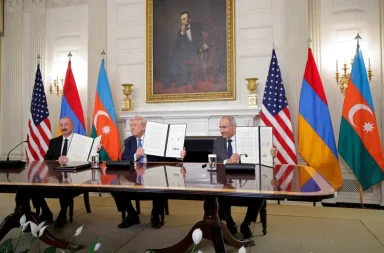Introduction
The formation of the First Republic of Armenia in 1918 stands as one of the most pivotal and emotionally charged moments in the modern history of the Armenian nation. It came on the heels of unprecedented calamities: the 1915 Armenian Genocide carried out by the Ottoman Empire, the collapse of the Russian Empire in 1917, a power vacuum in the Caucasus, a massive humanitarian crisis, and the looming threat of complete annihilation. Amid these historical tragedies, the Armenian Apostolic Church—one of the few surviving national institutions—played a decisive role in rallying the Armenian people toward survival and statehood.
Historical Background: A Nation on the Brink
By early 1918, Armenians had endured years of war, massacre, displacement, and despair. The genocide had decimated the Armenian population in the Ottoman Empire, while in the east, the Russian withdrawal from the Caucasus front left Armenians defenseless against advancing Turkish forces. Famine and disease ravaged civilians, and waves of refugees flooded into Eastern Armenia. The nascent Armenian National Council, facing internal divisions and external threats, declared independence on May 28, 1918, in a desperate bid for survival. This was the first expression of Armenian sovereignty since 1375, marking a historic milestone for the Armenian nation.
The Moral Authority of the Church
The Armenian Apostolic Church, long a custodian of Armenian identity during centuries of statelessness,naturally stepped into its historical role. Catholicos Gevorg V Surenyants, enthroned in 1911, quickly became more than a religious leader. His firm stance and unyielding dedication to the nation earned him universal respect.
In a series of encyclicals and public addresses in early 1918, Gevorg V called upon the Armenian people to resist and unite, famously declaring:
“This land is not just soil—it is baptized with the blood of our saints and ancestors. To abandon it is to betray our soul.”
His leadership reinforced the idea that defending the homeland was not merely patriotic, but a sacred Christian duty.
Sardarapat: Faith in Arms
The defining moment for the Church’s role came during the Battle of Sardarapat (May 21–29, 1918), which halted the Ottoman advance just miles from Etchmiadzin and Yerevan. Without this victory, there would have been no Armenian republic.
At the battle’s critical moment, Gevorg V issued his now-famous call to arms:
“The hour of salvation has struck. Let the church bells ring not for mourning, but to awaken our sons to arms. Let each Armenian remember: this land is holy, and its defense is sacred.”
Priests rallied the population, ringing bells across the Ararat plain and joining the ranks of soldiers. Clergy members carried crosses into battle, blending spiritual fervor with military courage, greatly contributing to the morale that led to victory.
In the aftermath, Gevorg V proclaimed:
“We stood as one body, one faith, one nation. Let this be the beginning—not of mourning—but of resurrection.”
Humanitarian Relief and Education
Following the republic’s founding, the Church immediately addressed the immense humanitarian crisis. Tens of thousands of orphans, widows, and wounded soldiers required urgent care. The Church established orphanages, shelters, and medical aid points, often within monastery complexes. It coordinated humanitarian aid distribution and collaborated with international organizations like Near East Relief to alleviate suffering.
Education also became central. Clergy reopened seminaries and primary schools, teaching Armenian language, Christian ethics and history, viewing these as vital tools for national survival and renewal.
Political and Cultural Influence
Although officially separated from political authority, the Church—and specifically Gevorg V—remained influential. Gevorg V served as an informal advisor to political leaders, and his moral authority often shaped critical diplomatic efforts. Relations between the Church and the ruling Armenian Revolutionary Federation (ARF) were sometimes strained, but always underpinned by a mutual dedication to national survival.
Founded in 1890, the ARF was the dominant political force behind the First Republic. A socialist-nationalist party with deep grassroots support across the Armenian diaspora and Eastern Armenia, it had long advocated for Armenian self-determination, armed resistance to oppression, and social justice. During this period, the ARF formed the backbone of the republic’s government, leading both its legislative and military efforts while grappling with immense external threats and internal instability.
Despite ideological differences, especially on the separation of church and state, the ARF leadership often consulted with the Catholicos, recognizing the unifying power of the Church in maintaining morale and social cohesion. In this precarious moment of state-building, both the ARF and the Church saw themselves as defenders of the Armenian people—one through political and military means, the other through spiritual and cultural stewardship.
In diplomatic correspondence, Gevorg V emphasized Armenia’s historical and moral rights, famously writing to international representatives:
“We are not beggars before history. We are its witnesses and its builders.
Guardians of Identity
The Armenian Church acted not just as a religious institution but as a cultural guardian. Monasteries protected ancient manuscripts, religious art, and church treasures from destruction. Amid escalating Bolshevik and renewed Turkish threats in 1920, the Church remained a trusted institution,capable of uniting Armenians across divides.
Gevorg V encapsulated this resilience in one of his memorable statements:
“They may destroy our cities, burn our homes—but the spirit of Armenia shall live wherever her children pray in Armenian.”
Conclusion
The role of the Armenian clergy, particularly under the leadership of Catholicos Gevorg V Surenyants, was essential during the foundation of the First Republic of Armenia. At a time of existential crisis, the Church offered hope, unity, and moral clarity. It inspired resistance at Sardarapat, healed the wounded, sheltered orphans, educated the next generation, and sustained the national spirit. The legacy of this spiritual leadership continues to shape the core of Armenian national identity till today.
References
- Hovannisian, Richard G. The Republic of Armenia, Vols. I–IV. University of California Press, 1971–1996.
UC Press Link - Walker, Christopher J. Armenia: The Survival of a Nation. Croom Helm, 1980.
- Payaslian, Simon. The History of Armenia: From the Origins to the Present. Palgrave Macmillan, 2007.
Palgrave Link - Near East Relief Archives, 1915–1930: https://neareastmuseum.com/
- Archives of Etchmiadzin, Letters and speeches of Catholicos Gevorg V Surenyants (1917–1918), Mother See of Holy Etchmiadzin, Armenia.
- Der Matossian, Bedross. Shattered Dreams of Revolution: From Liberty to Violence in the Late Ottoman Empire. Stanford University Press, 2014


